We all strive to keep our dogs safe and healthy–and one important part of that safety is preventing pet theft. Dog theft is on the rise and a very real risk, regardless of your dog’s breed.
Statistics state that only 10 per cent of stolen pets ever make their way back to their families– others are sold, used as bait for dog fights, bred in a puppy mill, sold to a research lab or left to face other cruel fates.
Below we have information on how to keep your dog safe at home, on dog walks and when out and about.
Finally, you’ll also find information on the most commonly stolen dog breeds, how to prove ownership of your dog and several important pet holidays: Pet Theft Awareness Day in the United States; in the United Kingdom, Pet Theft Awareness Day and Pet Theft Awareness Week draw attention to this important issue.
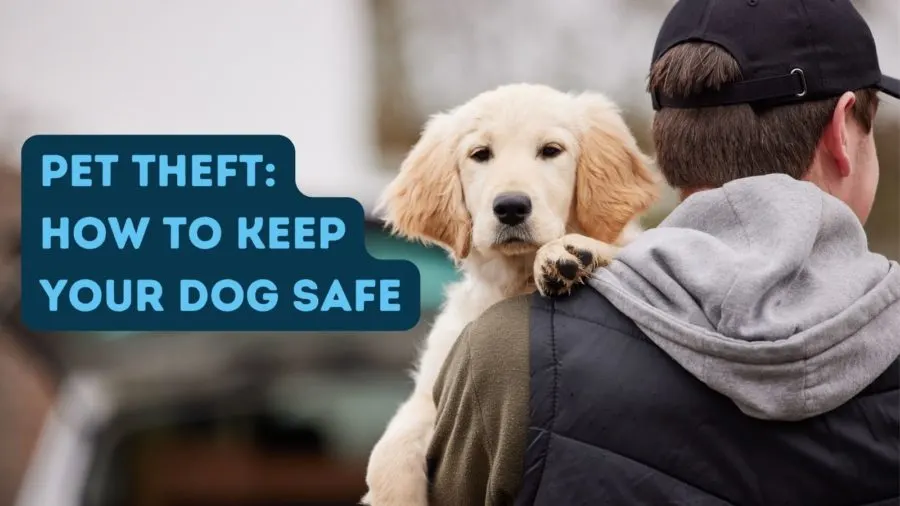
Preventing Pet Theft on Your Dog Walk
All dogs require regular exercise, but dog walks are a prime time for dog theft to occur. Below are the top tips to keep your dog safe on a walk:
Practice Recall and or use an extended lead: In case there is an emergency or threat to your dog, it’s vital to ensure they’ll respond to your calls. Try carrying strongly scented liver dog treats for your dog as this will greatly assist in recall.
Avoid Routine: Varying your dog walking route makes it harder for dog kidnapping gangs to track you and work out when to intercept and steal your dog.
Walk with a friend: Where possible, opt for safety in numbers; a friend will provide an extra witness and backup should you encounter a dognapper. Thieves may be less likely to attempt a theft when two people are present as well.
Do not give out your dog’s name: Putting your dog’s name on their collar, harness or ID may make it easier for strangers to lure them over.
Stay aware of your surroundings: keep your eyes on your dog and avoid distractions like mobile phones. Try to always have a charged phone and not wear earbuds when walking your dog.
Be seen and be heard as the owner: so as to make everyone aware that the dog is yours and you have a constant eye on it, to deter any dognappers.
Walk in open spaces: if you feel uncomfortable, try to opt for open, populated spaces where you can be easily seen.
Follow your instinct: if you suspect someone may be following you or raises your suspicions, leave the area quickly.
Keeping your dog safe while out and about
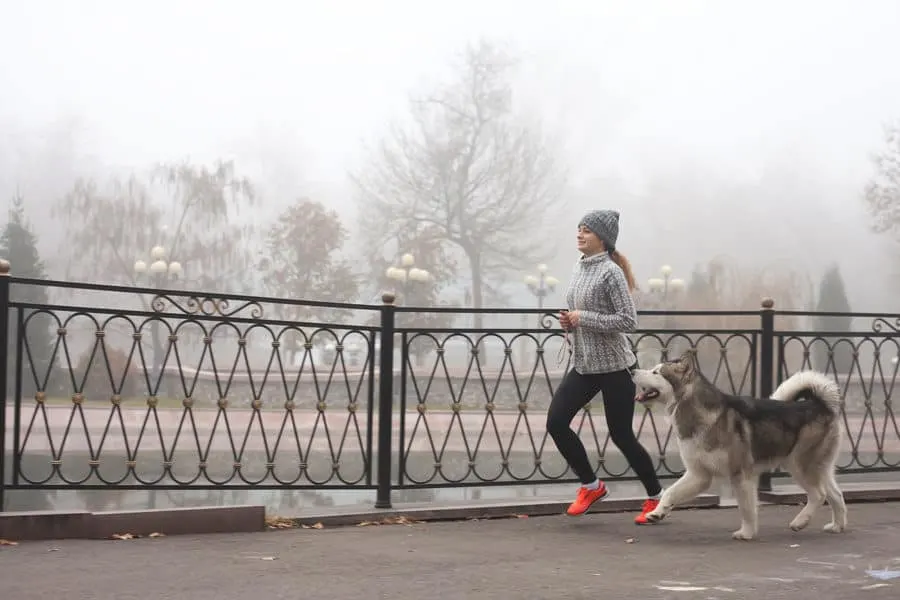
Avoid location tags on social media: this prevents thieves from knowing your address or where you regularly attend with your dog.
Extra vigilant: report any suspicious activity you see.
GPS tracking collar: consider investing in a GPS tracking collar, this will allow you to know your dog’s location at all times.
Be careful of strangers asking you a lot of questions: always be wary of an unknown person asking unusual or constant questions about your dog (both on and offline).
Dog walking/kennel/groomer services: always carry out complete, extensive checks to see if they are trustworthy and reputable.
Note emergency sos shortcuts on your phone: these can help if you feel threatened or unsafe.
Carry an alarm device: these can help to scare attackers and attract attention.
Refuse help from strangers: unless absolutely necessary, avoid stranger’s offers for help with your dog.
Tint your car windows: dognappers have been known to steal canines from cars (although the best advice is never to leave your dog alone in the car, even with the AC on or on chilly days).
Put yourself between your dog and the road: walk your dog away from the curb.
An adult should always be in control of your dog: ensure children always walk dogs in the presence of an adult as dognappers may be more likely to target those they see as less likely to resist.
Find local dog friendly stores: your dog is always safest with you; locate stores so you can take your dog on some of your errands or otherwise leave your dog safely at home.
Preventing dog theft from your home

Protect home and secure property: consider dog cameras, CCTV, and video doorbells.
Dogs are easily taken from gardens: especially front gardens, so make sure to secure your garden with tall fences.
Lock and alarm gates: to prevent unwanted intruders.
Leave a light on if your dog is home alone: this can be helpful in the evening, so it looks like someone is in. Alongside this, always turn an outside light on for supervised late night toilet trips so you can see your dog at all times.
Outdoor kennels should also be alarmed and locked: for any dogs kept outdoors, ensure kennels have sufficient security.
Gravel your path or driveway: this makes it harder for intruders to discreetly approach.
Regularly test your home alarm: to ensure it’s in working order.
Lock your dog door or flap when not in use: and don’t leave the window open in the room your dog is in.
Don’t showcase new puppies online: be careful oversharing any new pets; puppies are especially valuable to dog nappers.
Preventing Puppy Theft
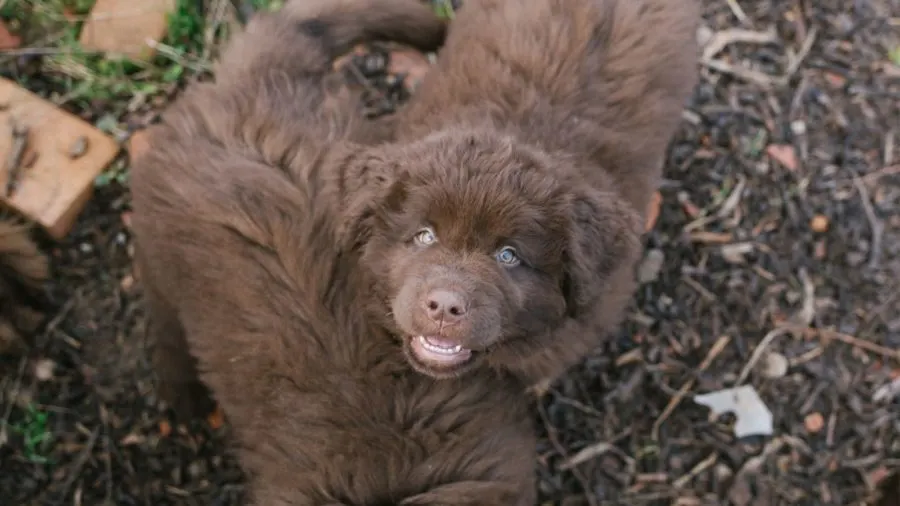
Puppies that are not chipped are more valuable as they have no ID: be extra careful in protecting puppies as they are prime targets.
Be extra careful with pedigree dogs: they are the most valuable and therefore the optimum targets.
Neutered dogs will deter thieves: as some thieves look to steal pets to breed them, a neutered dog will be less of a target.
When adopting out or selling puppies, have someone else present: limiting the number of people and showing them in only one, secure area can protect your dogs from theft.
How to Prove Your Ownership of Your Dog
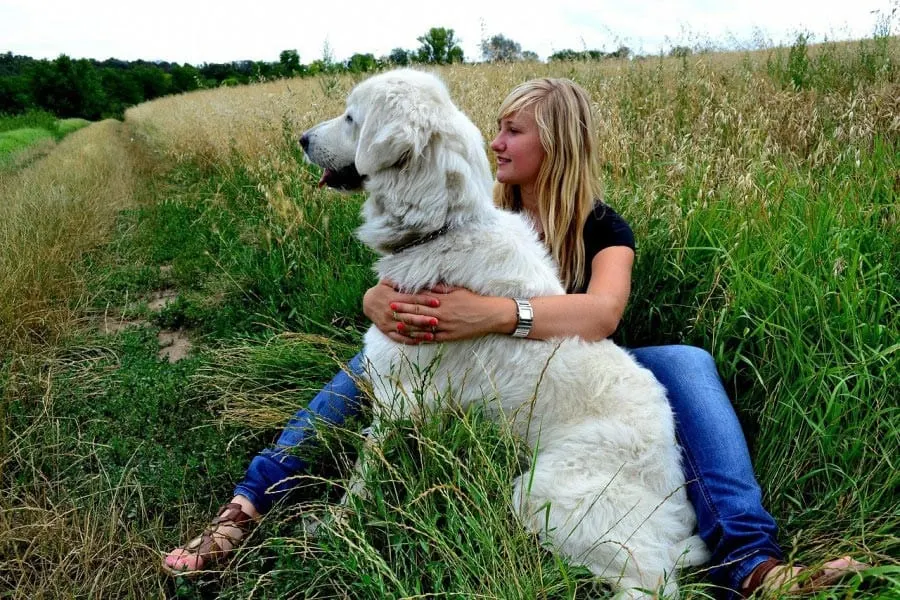
Proof of ownership: it is important that you have documentation of ownership in order to make sure there is no dispute should your dog be lost or stolen.
Keep ID collar tags up to date: make sure your current mobile phone number and other contact details are on the tag.
Get your dog microchipped: this will be done by your vet, it will be relatively pain free for the dog and cheap to do.
Be sure to take photos of your dog: keep in mind capturing many angles and any identifying features. Take a photo of you with your dog too, and before and after grooming.
Your dog’s DNA: if you’re really worried about dog theft then consider collecting their DNA to match later on if needed. There are services that can help with this.
Financial tips
Pet insurance: make sure this covers theft.
Be careful with rewards: if offering a reward for your dog, make sure information is correct and your dog is found before giving the money.
Keep all your documents safe: to be accessed in an emergency.
What is the Most Commonly Stolen Dog Breed?
Like Lady Gaga’s dog who was stolen (then thankfully reunited), the French Bulldog is the most commonly stolen dog.
Here’s a list from Puppy Hero of dog breeds that are most likely to be stolen; as you can see by the average price of these breeds, the price of the dog is definitely related to the likelihood of pet theft:
| Ranked by likelihood to be stolen, according to petkeen.com | Dog Breed | Price ($) in 2022, mostly according to countryliving.com |
| 1 | French Bulldog | 2,112.70 |
| 2 | Bulldog | 2,747.82 |
| 3 | Yorkshire Terrier | 1,431.20 |
| 4 | Chihuahua | 1,248.95 |
| 5 | German Shepherd Dog | 1,305.52 |
| 6 | Maltese | 1,299.98 |
| 7 | Shih Tzu | 1,238.29 |
| 8 | Labrador Retriever | 1,572.67 |
| 9 | Poodle | 1,099.98 |
| 10 | Siberian Husky | 1,059.99 |
What Should You Do If Your Dog is Stolen?
The National Association of Professional Pet Sitters (NAPPS) has some excellent tips on what to do if you believe your dog has been stolen:
- If you believe your pet is stolen, call or visit your local animal shelter and government agency immediately, and continue contacting these organizations daily.
- Search everywhere. Explore any potential hiding spots, and check with all family members.
- File a police report with your local law enforcement agency. If there have been a string of pet thefts in your region, this information will assist in fully investigating the crimes.
- Canvas the neighborhood. Distribute flyers with your pet’s photo, talk with neighbors, and ask delivery individuals if they have seen your pet or spotted any unusual activity. Call your pet’s name over and over.
- Create and post signs with a clear photo of your pet and detailed descriptions.
- Register your pet with Amber Alert for Pets, a nationwide network of pet parents committed to seeing lost pets safely returned home.
- Consider securing a pet insurance policy that includes coverage for cases of theft, such as VPI Insurance.
Pet Theft Awareness Day
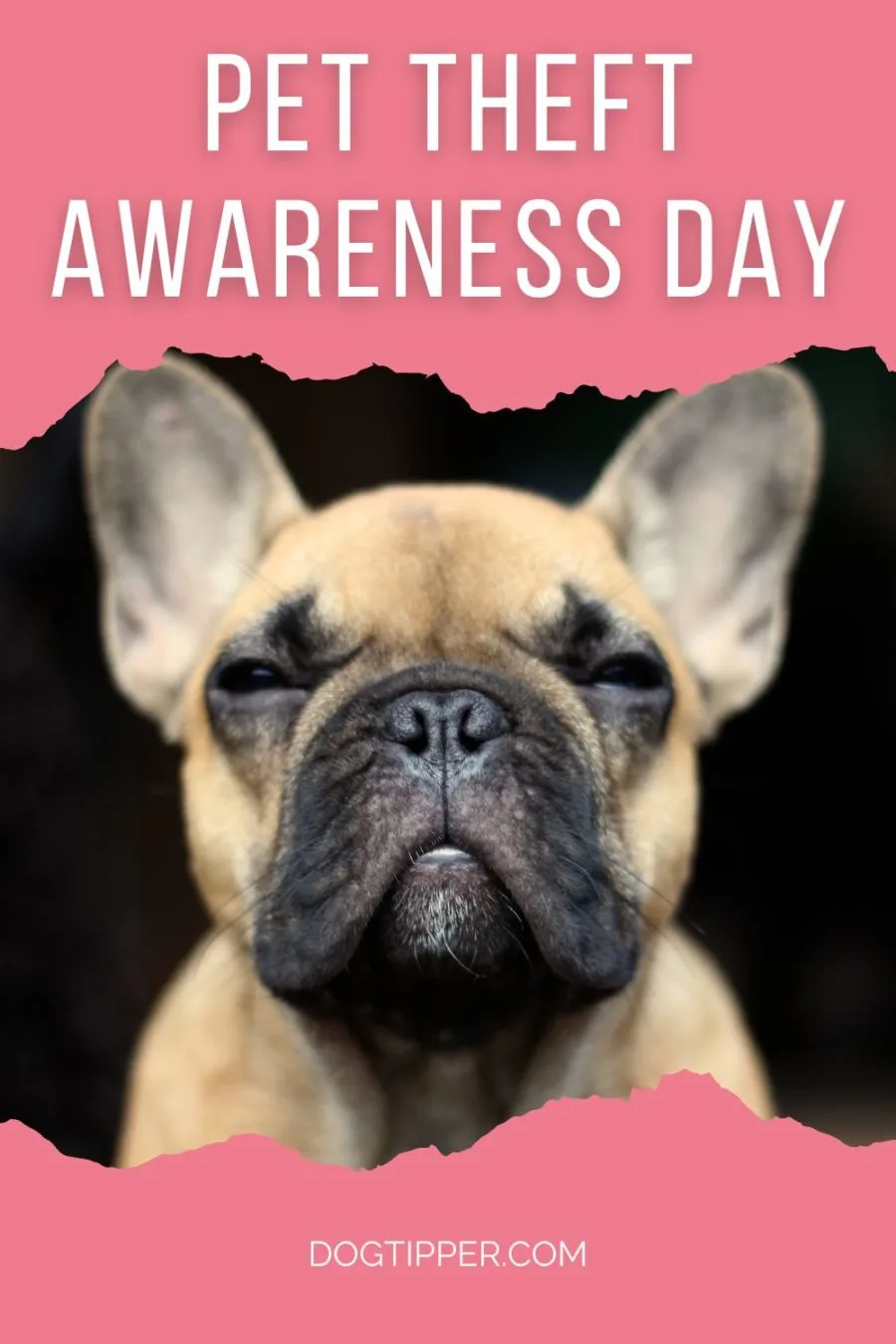
Last Chance for Animals, a non-profit organization which champions an array of animal rights issues, helps to shine a spotlight on Pet Theft Awareness Day and the plight of roughly 2 million companion animals in the United States who are stolen each year.

In the US, Pet Theft Awareness Day is observed every February 14.
Valentine’s Day is traditionally a celebration of love that steals your heart away, but this pet holiday is also a time for all pet parents to protect their hearts from being broken by the theft of their dog or cat companion.
Statistics state that one out of every three pets will become lost in their lifetime. Many of the missing are never reunited with their human families, and can end up facing life in a puppy mill or as a bait dog.
Make a date to see if you can check off all the items in Last Chance for Animals’ Pet Theft Awareness Day list, which is filled with advice that could save your pet’s life:
- Have your dog spayed or neutered, which will both deter Rover from roaming and help the problem of pet overpopulation–and make your dog less appealing to thieves.
- Never leave your tail-wagging chum unattended in a car, outside a store, or even in your own yard.
- Ensure that your dog cannot be seen from the street.
- Remember that those “free to a good home” ads can come at a heavy price– the well-being of our four-legged friends. Replies to such ads often come from class B dealers who acquire free canines and cats to resell. If you need to rehome a companion animal, contact a reputable rescue group.
- If your dog disappears, one way to increase the chances of a happy reunion is to make sure that your pet has both an ID tag and a permanent form of identification, such as a microchip.
- Keep a current snapshot of your dog and a written description with you at all times, in case of an emergency.
- Provide proper identification for your pet with an ID tag or have your dog microchipped.
UK’s Pet Theft Awareness Day and Pet Theft Awareness Week
Pet theft is far from being only a US problem, however; pet theft is also on the rise in the United Kingdom.

In the US, animal lovers have designated Valentine’s Day as a date to discover ways to guard their hearts against the loss of their canine or cat companion to pet theft. Across the pond, pet parents mark the somber pet holiday each March with both an awareness day and awareness week to mark Pet Theft Awareness.
The UK’s Pet Theft Awareness Day is March 14, and Pet Theft Awareness Week is the week beginning March 14 each year.
How Did Pet Theft Awareness Week Begin?
A German Shorthaired Pointer who vanished in a white van during a supervised day of play with her brothers and sisters in late 2012, Angel was never reunited with her loving family.
Her memory acts as a guardian angel for other innocent animals, however, thanks to the director of the social media-based organization The Dog Union and a staff member at VioVet, who were inspired by the search for the lost dog and a social media graphic on the topic to create Pet Theft Awareness Week.
How Many Dogs Are Stolen?
According to a Pet Theft census, in 2013 a minimum of three dogs and cats are stolen from their forever families every day in the UK.
The majority of pets (52 percent) disappear from their family garden, but thieves have also taken people’s dogs and cats while breaking into a home, run away with people’s canine companions during dog walks, stolen pets as they wait patiently outside a store for their guardian, and even spirited away with companion animals who are inside shops. The causes for the criminal act range from ransom and selling the dog online to breeding and dog fighting, with small dogs used as bait.
Sadly, 46 percent of dogs who disappear due to pet theft in the UK remain missing one year after they vanished. To turn the tide on the staggering statistic, Pet Theft Awareness Week offers the following advice to keep your canine companion safe:
- A dog should never be left unattended outside a store while their guardian goes shopping.
- Be aware of surroundings when going on a stroll with Spot, as thieves have been known to steal canines on constitutionals with their pet parent.
- As more than half of dogs stolen were in the family garden at the time of their abduction, make sure the area is secure.
- Take a picture of your pet periodically for use in case of your dog’s disappearance.
- Have your dog microchipped, and keep contact info accurate.
- Ask your vet to check your pet’s chip during each visit.
Pet Theft Awareness Day
In 2017, the Stolen And Missing Pets Alliance (SAMPA) created Dog Theft Awareness Day , an annual event held on 14th March and is the start of Pet Theft Awareness Week.
According to SAMPA:
Prevention and Advice is top of the agenda while explaining why we need tougher laws to act as a deterrent to protect all our pets.
No one is safe from this crime, which hits families, the elderly and the disabled. The loss of a companion and family member is devastating.
The Stolen And Missing Pets Alliance’s (SAMPA) first Dog Theft Awareness Day was held in Parliament in 2017.
Over the last five years, we have seen a steady increase year on year and 2021 continues to surpass any expectations, with demands for dogs increasing during Covid lockdown and the trend continues with puppy prices at an all time high.
SAMPA Patron Dr Daniel Allen’s #PetTheftReform dog theft figures will be released on the 14th March, showing the regional police FOI numbers.
We are delighted to report the due to our work on Pet Theft Reform and the help of Tom Hunt MP, Siobhan Baillie MP, Iain Duncan Smith MP, Robert Buckland MP and Priti Patel, the Government set up a Pet Theft Taskforce which resulted in the news that Dog Abduction would become a specific offense in the Kept Animal Bill and is working its way through Parliament now.
The new law will give courts access to appropriate custodial sentences to act as a deterrent, provide punishment, and protect the public and give the Police more powers.
Our concern now is what happened to cats? Cats are family too! Our co-founders at PetTheft Awareness have recorded a cat theft increase from FOI police data and their new report will be released during Pet Theft Awareness Week. There is also a petition to include cats in the Dog Abduction offfence: Petition link to sign
Organised crime has been the driving force behind Dog Theft, which is a criminals dream job, because it’s seen as low risk with high rewards. The new Dog Abduction offence will act as a deterrent and give pet owners more protection.
Until the new law is in place to protect our dogs they will continue to be listed under ‘other thefts’ as second hand goods with low replacement value.
We know there have been many reports in the national and local press over the last few months on the increasing numbers of dog thefts and attempted dog thefts. We just want to point out that fortunately the risk to each of us is low, and being Dog Theft Aware, will reduce the risk further by following simple guidelines.
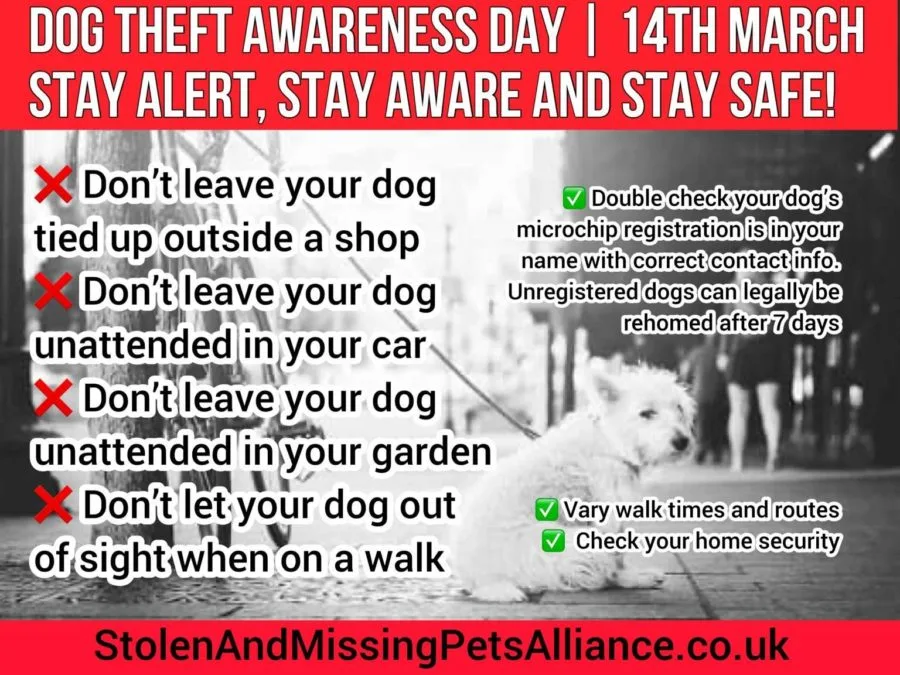
- How to Calm a Dog During Fireworks - June 20, 2024
- Taking Your Dog to See Santa: Tips for a Jolly Visit! - December 7, 2023
- The Pug Dog Price Tag: What You Need to Know Before You Get Your Pug - September 7, 2022
